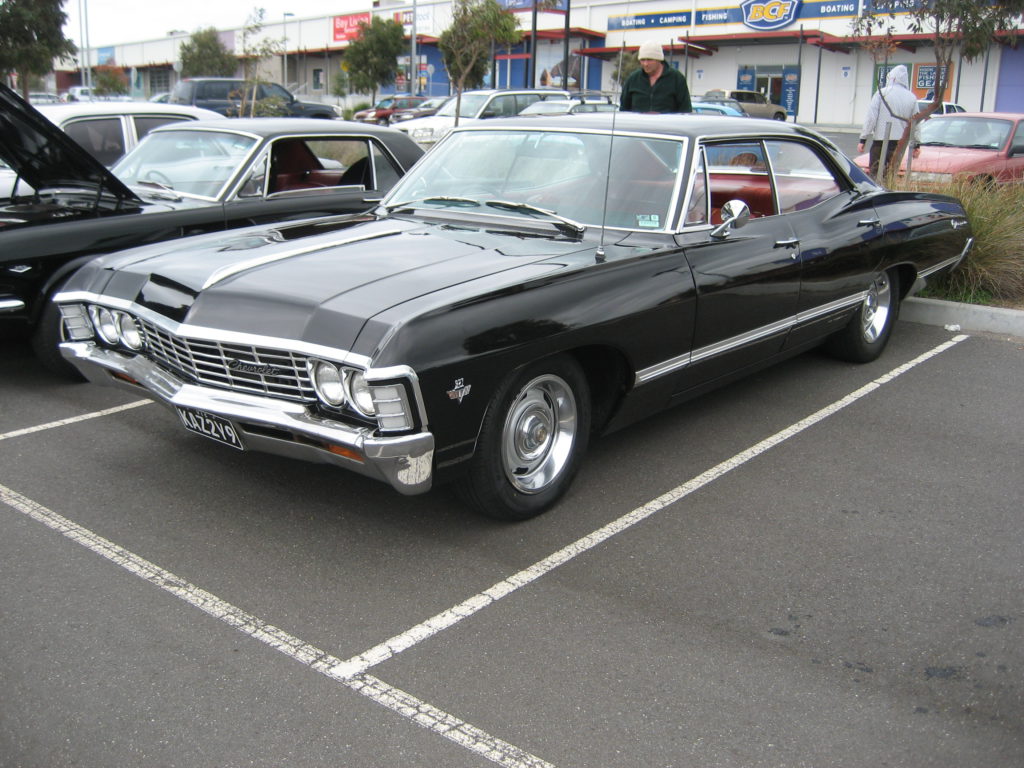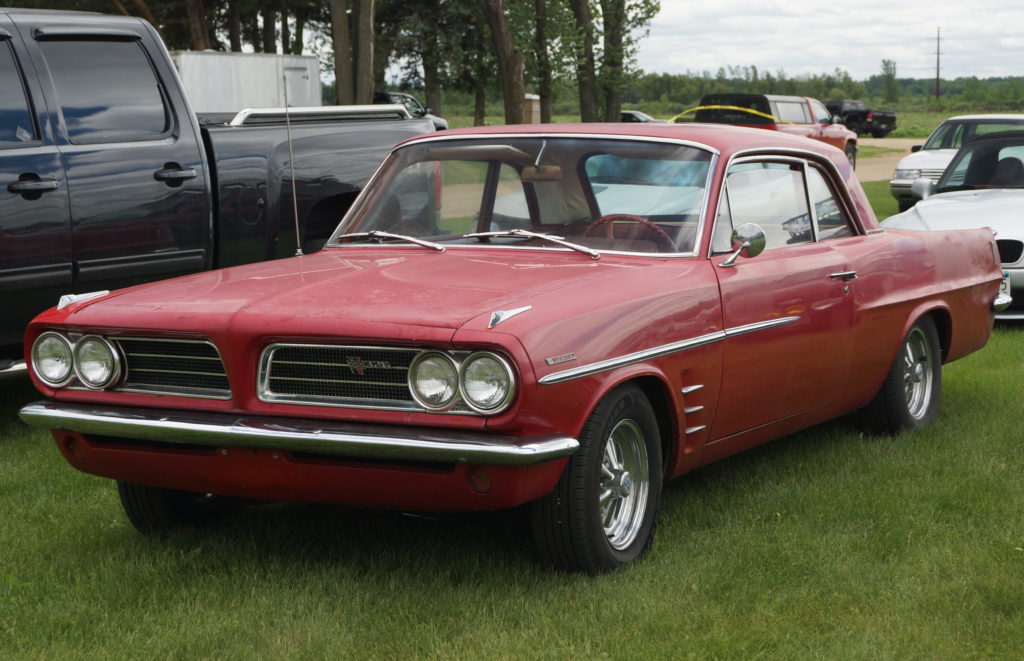Ever wondered what lurks behind suburban driveways and plain badges? You’d never guess the truth. Beneath the modest hoods of 1960s family cars hid monster engines ready to shock anyone at a stoplight. And boy, did they deliver! These sleeper cars packed NASCAR power in packages so ordinary most people drove right past them. Imagine that – families could haul groceries and smoke Mustangs with equal ease, all from checking the right boxes on order forms.
These forgotten giants of American roads tell a secret history of horsepower that’s waiting for you to discover.
8. 1969 Chevrolet Kingswood 427 Wagon (Exterior)

When soccer practice ended and the highway opened up, few expected a family wagon to leave muscle cars in its rearview mirror. Supercar performance hid behind family-friendly styling in the 1969 Kingswood 427. Clean sides, subtle trim, and often wood-grain paneling provided perfect camouflage for the muscle car heart beating beneath the hood. Massive engine compartment dimensions easily accommodated the 427 V8, while the long roof maintained perfect proportions. Neighbors mistook it for just another suburban family vehicle thanks to its two-way tailgate and spacious cargo area. Extremely low production numbers with the 427 engine option have made this Chevy wagon one of the rarest sleepers of the muscle car era.
1969 Chevrolet Kingswood 427 Wagon (Interior)

Need to haul the family, groceries, and still smoke a Mustang at the stoplight? The Kingswood’s interior delivered this unlikely combination. Family functionality balanced with performance underpinnings inside the spacious cabin. Front bench seats, massive cargo space, and fold-down rear seating accommodated both kids and cargo with ease. Backward-facing third-row seats gave younger passengers a view of defeated muscle cars disappearing in the distance. Unsuspecting sports cars often fell victim to the 335 horsepower delivered by the 427 V8 engine. Air conditioning and power steering were available luxury options, creating a comfortable cruiser for daily use. Heavy-duty cooling systems ensured the big-block ran smoothly even when hauling a full load of family and gear.
7. 1967 Chevrolet Biscayne 427 (Exterior)

Zero to 60 mph in 6.1 seconds from an unassuming family sedan shocked stoplight challengers in 1967. Massive power lurked behind the Biscayne’s plain-Jane styling. Minimal chrome, dog-dish hubcaps, and zero flashy badges provided perfect camouflage for the optional 427 cubic inch V8 engine underneath. Police departments and budget-minded buyers gravitated toward base models, while speed enthusiasts checked the RPO L72 option box to get 425 horsepower in a package nobody saw coming. Square-off rooflines and clean flanks gave no hint of this Chevy’s true performance potential.
1967 Chevrolet Biscayne 427 (Interior)

If you’re the type who prefers substance over flash, the Biscayne’s interior delivered exactly what mattered. Budget roots showed through inside with basic bench seats, rubber floor mats, and minimal instrumentation. Comfort features disappeared in Chevrolet’s focus on raw performance and weight reduction. A simple steering wheel, minimal dash padding, and manual windows, steering, and brakes came standard unless optioned otherwise. Weight and price stayed low with this no-frills approach, making the 427 Biscayne accessible for street racers who prioritized 14.6-second quarter-mile times over creature comforts.
6. 1965 Dodge Coronet 426 Street Wedge (Exterior)

The 365 horsepower lurking under the Coronet’s hood delivered muscle car thrills without the attention-grabbing styling. Conservative design concealed this 1965 model’s performance potential. Hemi variants hogged the spotlight while the 426 Street Wedge flew under the radar with subdued body lines and minimal badging. Simple grille work, straight body lines, and subtle wheel covers gave no indication of the power beneath the hood. Similar-looking Coronets with six-cylinder engines populated fleet sales and dealership lots, making the V8 version a true sleeper. Dual exhaust tips barely visible beneath the rear bumper offered the only external clue to this Dodge’s performance capability.
1965 Dodge Coronet 426 Street Wedge (Interior)

Climbing behind the wheel of a ’65 Coronet 426, nothing prepared you for the surge of 470 lb-ft of torque when you pressed the accelerator. Straightforward design and function-first features defined the interior, matching its sleeper status perfectly. Plain vinyl bench seats, a simple dashboard, and minimal gauges provided just enough information to monitor the 426 cubic inch powerplant. Low-speed maneuvers benefited from the large steering wheel’s leverage, while a floor-mounted shifter delivered better control during hard acceleration. Minimal sound insulation in most examples allowed the big-block V8’s distinctive rumble to permeate the cabin.
5. 1962 Ford Galaxie 500 XL 406 (Exterior)

Want NASCAR performance without attracting police attention? The 1962 Galaxie 500 XL 406 delivered both in one conservative package. Serious muscle entered Ford’s full-size lineup with this unassuming model. Clean lines, modest chrome, and understated tail fins characterized its conservative body style, effectively hiding its racing pedigree from casual observers. NASCAR and drag strip domination motivated Ford to design a slippery roofline with minimal ornamentation. Two versions of the 406 cubic inch V8 powered these sleepers – a single four-barrel variant making 385 horsepower and a tri-power setup producing 405 horsepower through the rear wheels. Mid-14-second quarter-mile times came wrapped in what appeared to be a standard family car.
1962 Ford Galaxie 500 XL 406 (Interior)

Few interiors in 1962 could match the split personality of the Galaxie 500 XL. Performance paired with unexpected comfort inside this deceptive Ford. Bucket seats, a center console, and sporty round gauges contrasted sharply with the car’s conservative exterior styling. Luxury touches came with the XL package without compromising the performance-focused mission. High-speed cornering benefited from the large steering wheel’s leverage, while a floor-mounted shifter allowed drivers to bang through gears authoritatively. Specifically upgraded parts enhanced drag strip performance, giving enthusiasts an early taste of Ford’s budding muscle car potential.
4. 1968 Mercury Monterey 428 Police Interceptor (Exterior)

If you’ve ever wondered what police officers drove before modern pursuit vehicles, the 1968 Monterey represents highway patrol muscle at its finest. Serious pursuit power packed into an understated package defined this Mercury Police Interceptor. Clean, squared-off lines and minimal flash allowed this full-size cruiser to blend perfectly into traffic. Beneath the vast hood lurked a 428 cubic inch V8, while heavy-duty suspension components kept the car level despite its performance capabilities. Dog-dish hubcaps, blackwall tires, and zero external badging came standard on law enforcement models, making them virtually indistinguishable from taxi cabs or government fleet vehicles. Missouri State Highway Patrol officers relied on these cars extensively, contributing to their rarity and potent sleeper status today.
1968 Mercury Monterey 428 Police Interceptor (Interior)

Heavy-duty components built for constant police use meant the Monterey’s interior could withstand years of abuse while maintaining functionality. Function trumped form inside this purpose-built cabin. Firm padding and durable vinyl covered the bench seat, standing up to the rigors of long patrol shifts. Extended high-speed pursuits remained possible thanks to the heavy-duty cooling system, while upgraded brakes delivered improved stopping power. Authority came from the 340 horsepower engine pushing the big sedan forward, and an upgraded electrical system powered police equipment without strain. Column shifters equipped most Police Interceptors, creating valuable space between the seats for mounting essential equipment.
3. 1963 Pontiac Tempest LeMans 326 (Exterior)

Pontiac engineers pulled off one of Detroit’s best deceptions by squeezing 336 cubic inches into an engine badged as a “326.” Clean styling disguised numerous engineering innovations when the 1963 Tempest LeMans arrived on the scene. Subtle body lines, modest chrome trim, and understated badges gave no hint of the car’s performance potential. Compact dimensions amplified the impact of the V8, which pushed the car with surprising authority. Stacked headlights and a simple grille defined the cleanly styled front end, while minimal ornamentation adorned the rear. Pontiac tested the intermediate muscle car waters with this LeMans, laying groundwork for the legendary GTO’s later arrival.
1963 Pontiac Tempest LeMans 326 (Interior)

The unique transaxle design shifted weight rearward for better traction, eliminating the wheel-spin common in other performance cars of the era. Sportiness balanced with daily usability through thoughtful interior design in the LeMans. Bucket seats, a floor shifter, and clean instrumentation elevated the driving experience beyond typical early Sixties fare, giving it a bit of a futuristic appeal. Basic vinyl upholstery and minimal sound deadening kept the weight down and performance up in most examples. Impressive 260 horsepower flowed from the 326 V8 – a misleading badge applied due to GM regulations despite its actual displacement.
2. 1966 Studebaker Daytona Sports Sedan (Exterior)

Front disc brakes provided stopping power far beyond most American cars of the era, making the Daytona one of the safest performance cars available. Final performance ambitions from Studebaker appeared in this 1966 Sports Sedan. Clean, European-inspired styling with minimal chrome and understated proportions defined this compact model. Squared-off roofline, simple grille, and subtle wheel covers gave no indication of the car’s sporting intentions. Extremely low production numbers transformed these cars into instant rarities, and they disappeared from American roads almost as quickly as they arrived.
1966 Studebaker Daytona Sports Sedan (Interior)

If you appreciated European sports sedans but wanted American V8 power, the Daytona’s cabin delivered this rare combination. Driver-focused environment ahead of its time greeted those who stepped inside. Bucket seats, floor shifter, and full instrumentation set this Studebaker apart when many competitors still relied on bench seats and column shifters. Respectable performance for the era flowed from the 283 cubic inch V8 through either manual or automatic transmissions. Controls remained within easy reach thanks to the clean dashboard design, while excellent outward visibility made the car easy to place on winding roads. Interior build quality stayed surprisingly high despite the company’s financial troubles, with materials that withstood years of daily use.
1. 1964 Buick Skylark Gran Sport (Exterior)

Tired of choosing between luxury and performance? Buick’s performance era launched with the perfect solution in the 1964 Skylark Gran Sport. Clean body lines, tasteful chrome accents, and understated badges never betrayed the power hiding underneath this intermediate model. Elegant Skylark proportions gained 401 cubic inch V8 power with the Gran Sport package, creating what many called a gentleman’s muscle car. Signature sweepspear side trim and a clean roofline spoke more of upscale luxury than aggressive performance. Unique design elements mixed traditional Buick luxury with newfound performance capabilities, setting the Gran Sport apart from more brutish rivals.
1964 Buick Skylark Gran Sport (Interior)

A massive 445 lb-ft of torque made the Gran Sport’s acceleration feel more like a luxury yacht than a muscle car – effortless and smooth. Luxury beyond what other muscle cars could match defined the interior appointments. Comfortable bucket seats, full instrumentation, and genuine wood trim elevated the driving environment to near-luxury status. The nailhead V8 produced 325 horsepower through either manual or automatic transmissions, delivering power with refinement. Upgraded handling components made Gran Sport models more agile than their substantial size suggested. Mature buyers seeking power without compromising civility found a unique niche in this Buick, which combined comfort and performance in ways most competitors couldn’t approach.




























